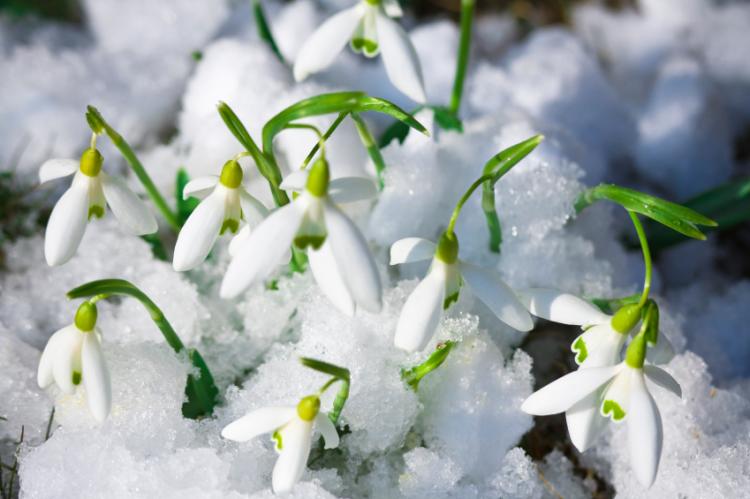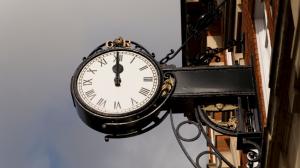
Best Comet of 2025?
C/2024 G3 (ATLAS) has already become very faintly visible to the naked eye for observers in the Southern Hemisphere.
Candlemas is a Christian holiday celebrated annually on February 2. It celebrates three occasions according to Christian belief: the presentation of the child Jesus; Jesus’ first entry into the temple; and it celebrates the Virgin Mary’s purification (mainly in Catholic churches).

The Candlemas Bells, also known as Snowdrops, symbolize hope according to Christian belief.
©iStockphoto.com/ gaspr13
Many Christians consider Jesus as the “light of the world” so it is fitting that candles are blessed on this day and that a candle-lit procession precedes the mass. It is traditional to eat crepes on Candlemas in some parts of Europe, such as France. Each family member prepares and cooks a crepe while holding a coin in hand. This is believed to assure wealth and happiness until the next Candlemas celebration.
Candlemas is also known as Candelaria in Spanish speaking countries. Whoever finds baby figures hidden inside the Rosca de Reyes (Kings Cake) on Epiphany on January 6 is obliged to bring food to a gathering held on February 2. Many Orthodox Christians celebrate this event by bringing beeswax candles to their local church and requesting for these candles to be blessed to be used in the church or at home. Some Christians observe the practice of leaving Christmas decorations up until Candlemas.
Many Christians observe Candlemas but it is not a public holiday in countries such as Australia, Canada, the United Kingdom and the United States.
Candlemas primarily focuses on Jesus’ early life. Many Christians believe that Jesus’ mother Mary presented him to God at the Temple in Jerusalem after observing the traditional 40-day period of purification (of mothers) following his birth. According to a New Testament gospel, a Jewish man named Simeon held the baby in his arms and said that he would be a light for the Gentiles (Luke 2:32). It is for this reason that this event is called Candlemas.
Many people believe that some of Candlemas’ activities stem from pagan observances such as Imbolc, a Gaelic festival, or the Roman feast of Lupercalia. However, others have argued that there is too little evidence to shed light on Candlemas’ substitution for these festivals. Either way, Candlemas occurs at a period between the December solstice and the March equinox, so many people traditionally marked that time of the year as winter’s “halfway point” while waiting for the spring.
According to some sources, Christians began Candlemas in Jerusalem as early as the fourth century and the lighting of candles began in the fifth century. Other sources say that Candlemas was observed by blessing candles since the 11th century. An early writing dating back to around 380 CE mentioned that a feast of the Presentation occurred in a church in Jerusalem. It was observed on February 14. The feast was observed on February 2 in regions where Christ's birth was celebrated on December 25.
Candlemas is known as the “Feast of the Presentation of Christ in the Temple” in many eastern churches. Other traditional names in the western churches include the “Feast for the Purification of the Blessed Virgin Mary” as well as the “Meeting of the Lord”. It is also Groundhog Day in the United States and Canada on February 2. According to folklore, the badger comes out to test the weather in the United Kingdom.
Snowdrops (galanthas nivalis) are known as Candlemas Bells because they often bloom early in the year, even before Candlemas. Some varieties bloom all winter (in the northern hemisphere). The superstitious used to believe that these flowers should not be brought into the house prior to Candlemas. However, it is also believed in more recent times that these flowers purify a home.
According to folklore, an angel helped these Candlemas bells to bloom and pointed them as a sign of hope to Eve, who wept in repentance and in despair over the cold and death that entered the world. Many Christians see the flower as a symbol of Jesus Christ being this hope for the world. Candles that are lit during Candlemas also symbolize Jesus as the “light of the world”.
Note: Please note that the seasons and seasonal changes mentioned in relation to Candlemas refer to the northern hemisphere in this article.

C/2024 G3 (ATLAS) has already become very faintly visible to the naked eye for observers in the Southern Hemisphere.

How does the 12-hour clock system work? Is midnight 12 am or 12 pm?

Why do many countries set the clocks back and forth an hour twice a year?

Why are there 12 months? How long are they, and what do the month names mean?